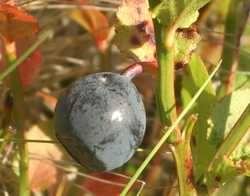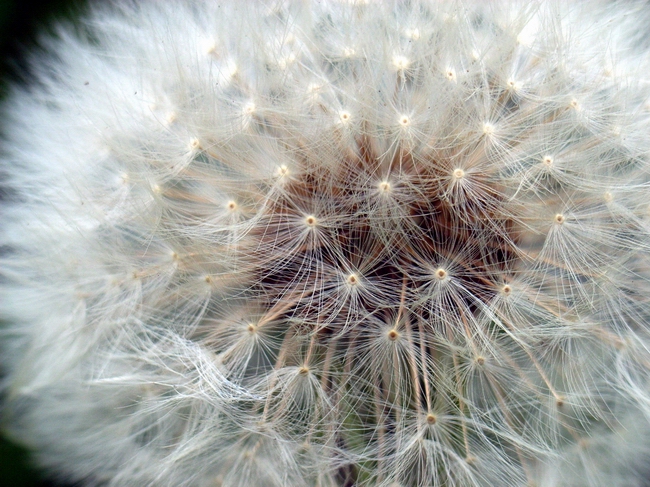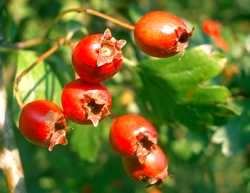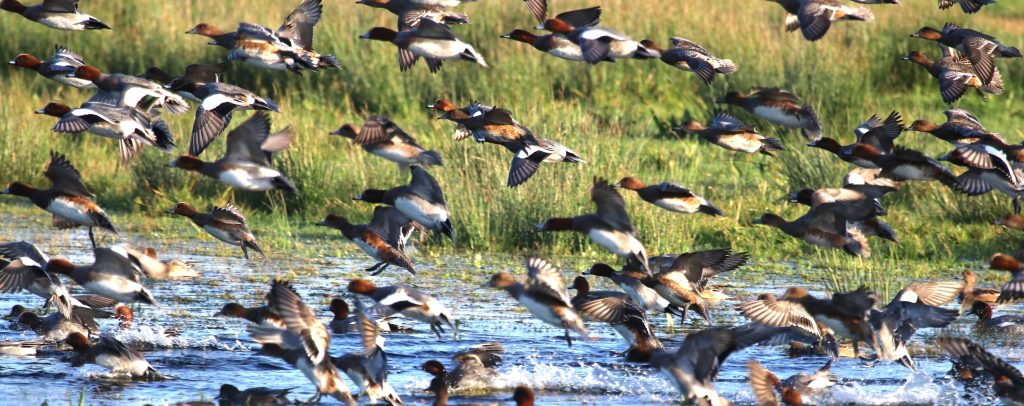This month look out for:
- Last of the autumn colours in the hedgerows and woodlands
- Last summers nests reveal themselves in the tress and bushes
- Red berries, such as on yew, hawthorn (haws) and holly, in hedgerows
- Bird flocks building up in wetlands and estuaries, including geese, swans and waders
- Final passage (bird) migrants seen
- Arrival of redwings, fieldfares, lapland buntings and waxwings
- Starlings from Scandinavia build up on specialist sites and form shapeshifting murmurations
- Seal pups on beaches
- Atlantic salmon moving to spawning grounds
- Fungi in woodlands and grasslands.



November starts in with a ‘bang’. The fireworks and bonfires of the 5th light up the sky and by now the nights can be bitterly cold. Bonfires can be attractive refuges for hibernating hedgehogs, and therefore should always be checked before they are lit, especially if you have used fallen leaves.
Hard frosts may have started and early mornings are often misty, as the dew from the ground condenses during the night. This month sees the last of the leaves on the deciduous trees falling to the ground. The only exception may be the beech, which may hang on to its coppery hues, and the larch with its yellow needles. Although the larch it not native, is it widely planted and its bright green, soft spring foliage and red young cones make it stand out from the rest. It is also unusual in being a conifer that looses its needles in Autumn. Most conifers drop them in small numbers all year round and are adapted to cope in winter with their full compliment of greenery.
The oak waits until November to put on its best Autumn show of colour, having only made a tentative start in October. The acorns rain down this month, often relying on jays and grey squirrels to disperse them. In some “mast” years, such as 2023, all trees somehow coordinate to produce a glut of seeds, but in other years there are very few. Hornbeam and beech also have mast years. The reason for this is that the trees produce more seeds than their herbivore predators can consume, hence increasing the chances of some seeds escaping from being eaten and then going on to germinate. In the lean years their predators may even surcome to starvation and their population be reduced.
There are two main types of British oak; the sessile and the pedunculate oak. In the former, the acorns are borne in cups, with almost no stalk attaching them to the stem. In the later, however, the acorn cups are attached with shared long stalks. The sessile oak is the more likely or the two to be found in the uplands of the west and the north. Other species, such as the holm oak (also known as the evergreen oak), are foreign imports, but are quite widespread.
At this time of year the black bryony stems thread through the hedgerows, supporting their clusters of fat, poisonous red berries.

Although gardens may hang on to their late flowers there is very little colour to be seen amongst the native plant species in November. The very last of the summer bird migrants leave, but now the trees are bare it is easier to spot the residents and winter migrants. Amongst the most likely birds to be seen in the gardens, woodlands and fields are flocks of roaming tits and finches (such as chaffinch and brambling). These are often joined by the occasional tree creeper and nuthatch. With every year that passes there are more blackcaps and chiffchaffs over wintering; you may be lucky to see them amongst these flocks. Rooks and crows seem to be everywhere once out of town, and jays and magpies are hard to miss also.
With the trees bare it it now much easier to see the extent of rookeries, with groups of nests high in the trees. Rooks will often be seen around the rookery even now. Perhaps they keep one eye on their own nests and one beady eye on the attractive sticks used in their neighbours’ nests. Or it may just be that they find it convenient to roost in or around the trees where they nest.
At this time of year, and through to the beginning of spring, winter thrushes (redwings and fieldfares) can also be abundant but are easily disturbed if you approach. They start to arrive about now and feast on hawthorn berries particularly. Blackbirds and robins also fly in from Scandinavia to spend the winter in our milder climate. Perhaps the highlights of the birding world during winter is to be seen on the lakes and estuaries. Waders and wildfowl can be super abundant having migrated from arctic regions following the breeding season.
Habitats and species
Parks and gardens: Clean out nest boxes now, to rid them of parasites and old nesting material. However, place some sort of natural lining back in them (such as wool, hay etc.) to provide comfort for roosting birds. In winter small birds will cluster together to help stave off the cold and nest boxes can provide ideal sites for this.
Ensure that you are providing hanging peanuts, sunflower kernels and scattered seeds for the different bird visitors. Also a source of water is really important. However if you start feeding the birds it is critical that you do not suddenly stop, as our feathered friends can become reliant on your handouts during harder times.
Woodlands (including wood pasture): In the woodlands the ground is covered in fallen leaves which rustle under foot. Fungi are also still appearing. Both edible and poisonous, but all fascinating. The sulphur tuft fungus grows on rotting wood and is widespread.
Arable and hedgerows: The old man’s beard is now finally opening out its fluffy seed heads. As leaves fall from the hedgerows it becomes that much more obvious.

Road verges: By the end of the month only a few scattered flowers remain. Grasses are mainly dead stems and where there is bracken this is brown.
Chalk and limestone grasslands: to follow
Meadows (neutral) and flood plain grasslands: Farmed grasslands will have been long since cut and most likely are being grazed by livestock in November, if dry enough. It is pretty much impossible to see plants species other than grasses, buttercups and plantains at this time of year in most cases, so its hard to tell how diverse a grassland actually is.
Acidic grasslands: to follow
Heathlands: to follow
Mountain and Moorlands (uplands): The breeding waders and summer migrants have left, leaving the uplands to the grouse, ptarmigan, red deer and mountain hares, where the ground is highest and countryside at its wildest.
Rivers and ponds (including bogs and mires): By November the wetland plants are starting to dieback and appear bedraggled. In the rivers the adult Atlantic salmon are migrating back to the place of their birth – the gravely shallows up stream. The fish arrive from the sea, entering the estuaries and then move on to the rivers. They swim against the current, driven to reach their final destination, where eggs are laid and fertilised (spawning), but where the adults will die, exhausted. During the journey, which will have taken many weeks, the males change both internally and externally. As the fish journey to their final destination they can be seen leaping out of the water to get over weirs and low waterfalls. This is a highlight well worth seeking out.
On some wetlands, starlings from the continent gather in their thousands, wheeling around in the sky “murmurations” before they dive into their reed roost.
Sea and the sea shore (including estuaries): Estuaries are filling up with more waders and wild fowl. Wigeon, teal, tufted duck and shovelers are particularly abundant ducks. The wigeon give the soundtrack to the spectacle with their high pitched call, and are accompanied by the startled lapwing ‘peewit’.

On the estuaries brent geese, curlew and shelduck forage with numerous types of gull and many waders.
Mammals: At this time bats enter a state of torpor in their hibernacula. This is not a full hibernation as bats will emerge on warm days, but is a state of reduced metabolism and body temperature. In this state less energy is required. Only dormice and hedgehogs hibernate. Some other mammals reduce winter activity, such as the badger, but will have fattened themselves up for the lean months ahead. Bank voles (below) remain active.

Around now grey seals give birth to their single offspring (pup) around the west, north and north-eastern coast. Seals only come to shore for extended periods during this time. Britain hosts half of the world’s grey seal population. The mother will feed the pup with milk for three weeks never leaving its side. Once the pup is old enough, the mother will visit the sea to feed. The pup takes two months to reach an age where it is able to join its mother. Its famous white fur turns grey after only two or three weeks. The seals also breed whilst ashore with one male (a ‘beach master’) taking a harem of upto ten females.
Birds: This month is the start of one of winter’s highlights – namely the amassing of huge flocks of starlings. Although it is not known quite why this happens, perhaps for protection against predators or the cold, in the early evening at certain sites thousands get together. They wield around the sky in dark masses and chatter and squawk. Eventually they seemingly fall to the roosts and all is once again quiet as they settle down. Roosts may be in cities, or in the countryside in reed beds for instance. Either way this is an amazing spectacle to watch. Other birds such as pied wagtails also show this behaviour.
Whooper and bewick swans return from the arctic to a number of wetland centres, particularly where they are encouraged by a free feed of grain. These are, however, totally wild birds and are both majestic and charismatic.
Robins, wrens and song thrushes may all be singing during warmer days. Although these songs are not as powerful and full of the gusto heard in spring they are welcome sounds. nevertheless.
Amphibians & Reptiles: Toads are now in hibernation, finding logs or stones to hide beneath until Spring arrives once more. Frogs are also hibernating at the bottom of ponds, or some other sheltered place, ready to emerge again in the following January.
Insects: Many insects overwinter in forms other than the adult, such as the pupa (moths and some butterflies) or the larva (caddis flies). Some remain as adults such as wasps. Adult ladybirds and peacock butterflies seek out warm nooks in sheds and attics to hide. Here the air is moist but not so cold.
Plants: If the weather has remained mild then some flowers can still be found in November, but many plants have died back above ground, leaving seeds heads for the birds to plunder. Trees may have all lost their leaves if the autumn has been stormy, but if not vibrant yellows, oranges and ochres can still be seen.
Fungi: This is the last month when the Autumn fungal-fest can be seen. These show-offs are the mushrooms and toadstools that we all think off when fungi are mentioned. Of course they can be found in any month of the year and take many different forms.
Fungi are as varied as black spots on leaves to huge bracket fungi that can take a man’s weight!


